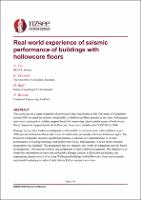| dc.contributor.author | Liu, Angela | |
| dc.contributor.author | Elwood, Kenneth | |
| dc.contributor.author | Bull, Des | |
| dc.contributor.author | Brooke, Nic | |
| dc.date.accessioned | 2020-06-18T13:44:20Z | |
| dc.date.available | 2020-06-18T13:44:20Z | |
| dc.date.issued | 2020-04-22 | |
| dc.identifier.uri | https://repo.nzsee.org.nz/xmlui/handle/nzsee/1718 | |
| dc.description.abstract | The cyclic test on a super-assembly of hollowcore floor and frames at the University of Canterbury around 2003 revealed the seismic vulnerability of hollowcore floor practice at that time. Subsequent tests were conducted to validate support details for improving seismic performance of hollowcore floors. Improved support details for hollowcore floors were introduced to NZS3101 in 2006.
Damage survey after Kaikoura earthquake confirmed the expected seismic vulnerabilities in pre-2006 precast hollowcore floors and it also revealed some previously unknown behaviour types. The Kaikoura earthquake provided significant impetus to advance our understanding of seismic performance of existing buildings with hollowcore floors. Subsequently, ReCast floors research programme was initiated. The programme has two streams: real-world investigations and lab-based investigations. The reported work is one component of real-world investigations. The objective is to obtain the information on observed earthquake damage patterns in Kaikoura earthquake, the engineering characteristics of existing Wellington buildings with hollowcore floors and currently used retrofit solutions in order to help inform ReCast research activities. | |
| dc.language.iso | en | |
| dc.publisher | New Zealand Society for Earthquake Engineering | |
| dc.relation.ispartofseries | 2020;90 | |
| dc.subject | Practice case studies in seismic retrofits | |
| dc.title | Real world investigation of seismic performance of buildings with hollowcore floors | |
| dc.type | Article | |

